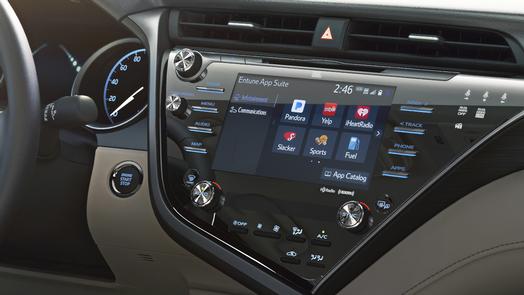 Toyota announced its third-generation Entune infotainment and connected car platform, Entune 3.0 that will offer connected car features, remote apps, dynamic maps, Wi-Fi hotspots, SOS calls and cloud connectivity. Select Toyota vehicles starting with the Camry will have Data Communications Modules (DCM) through Entune 3.0.
Toyota announced its third-generation Entune infotainment and connected car platform, Entune 3.0 that will offer connected car features, remote apps, dynamic maps, Wi-Fi hotspots, SOS calls and cloud connectivity. Select Toyota vehicles starting with the Camry will have Data Communications Modules (DCM) through Entune 3.0.
Entune 3.0’s cloud connectivity enables the vehicle to provide automatic notification of a crash (ACN) to dispatch emergency support under certain conditions. It also provides roadside assistance and stolen vehicle locator services. Users can press the SOS button for help with directions or other matters. Directions will be sent to the in-car navigation system.
The Toyota models with Entune 3.0 will offer in-vehicle Wi-Fi hotspots on the Verizon network which allows up to 5 devices to connect simultaneously to the Wi-Fi hotspot.
Through Telenav, Entune 3.0 will offer navigation, connected to your smartphone, through Scout GPS. When Scout GPS Link is activated on mobile devices, it can transmit turn-by-turn directions and even moving maps to the dashboard screen via Bluetooth and USB connection.
Vehicles equipped with Data Communications Modules will also update in maps in real-time. For properly equipped 2018 Camrys, Dynamic NAV will have the Toyota Smart Center analyze a four square mile grid around the vehicle. Any roads, or points of interest that are on the database in the Smart Center, but not in the onboard map will automatically be displayed on the head unit.
Dynamic NAV overlays the new road as you drive. And when you set a destination, the system verifies and updates the roads and POIs at your departure point, at your destination, and along your route so you can be sure to have the most up-to-date directions.
Smartphone users can use the Entune mobile device apps to remotely start/stop, lock/unlock the doors and even set features for drivers. Owners can receive warning alerts for excessive vehicle speed and geographic location outside a geo-fence.
With Entune 3.0, Toyota vehicles are connected to a selected dealership. Drivers can contact a dealer via the head unit display and paired phone for service question. The vehicle diagnostic data can be transmitted to the dealer; and customers will receive Vehicle Health Reports via the Toyota Owners website.
With Entune 3.0, the Entune App Suite will be offered as a standard feature across all Entune levels. Toyota customers will now enjoy Pandora, Slacker, iHeart Radio, Yelp and many other applications through a newly simplified and intuitive user experience (UX). The Entune app allows users tol keep their personalized preferences no matter which Toyota vehicle they are driving.
Toyota is a founding member of the SmartDeviceLink Consortium, a non-profit organization to manage open-source software supporting smartphone app development for vehicles.
SmartDeviceLink is a new open-source platform designed to help increase consumer choice and the ability to connect and control smartphones on the road. Vehicles equipped with SmartDeviceLink allow drivers to access their favorite smartphone apps using display screens, buttons, or voice recognition.
By 2020, Toyota plans to make embedded DCMs standard equipment in nearly every new vehicle sold in Japan and the U.S. Toyota’s plan is to connect all our vehicles and provide customers with services that truly enrich their lives and bond them to our brands.
Toyota is starting a pilot program with Getaround this year in San Francisco to test the use of Smart Key Box, to simplify the process of car sharing. Smart Key Box, uses a secure device that’s connected to a Controller Area Network. Using Smart Key Box, and a smartphone application, car-sharing users can lock, unlock, and operate the vehicle, without need for transfer of a physical key. Access is managed by the vehicle’s owner, with authentication codes issued by the TSC, between the smart phone, and the vehicle’s Smart Key Box. Control is still with the vehicle’s owner, but this is a safer, and more secure way of lending and sharing a vehicle.